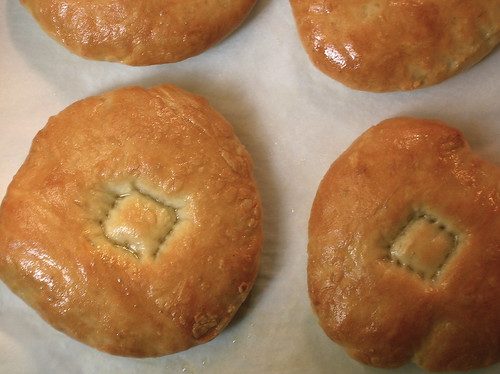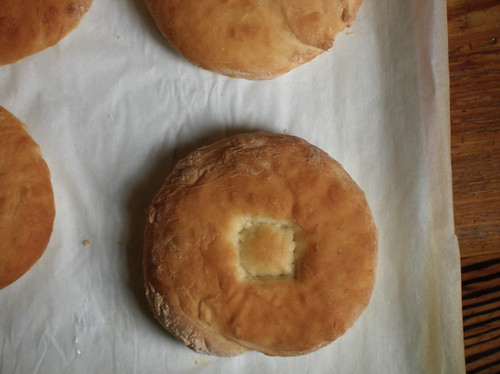
Several afternoons a week I rush out of work, heading across town for my Arabic tutoring session, which is really just an excuse for Wael and me to gab about the ongoing saga of his engagement and other such gossip. I tap my fingers on the window of the service, the van stuck in the smog-filled traffic of Damascus' rush hour. Finally reaching Bab Touma, I leap out and hustle into the winding alleys of the old city. Bab Touma is the Christian quarter of the old city and right at the entrance, between the chicken vendor and the kunafe maker, is a small bakery selling small twisted cookie rings and puffy round breads and sesame breadsticks. When my stomach grumbles I stop quickly, paying a few coins for one of those soft breads, pressing it to my nose to inhale its orange water scent before hurrying on my way.


The bread is called qurban, which means sacrifice, and it is the bread used during communion for the Orthodox Christian churches of Syria and Lebanon. But don't worry, my afternoon snack isn't sacrilegious, qurban are often for sale for public consumption. You can literally smell this bread baking from blocks away, the scent of orange flower water and yeast hooking your nose like a ring though a cow's nostril. They are best when your nose draws you to them, fresh out of the oven, the sweet rounds marked in the center with a stamp in Aramaic, soft and lightly sweet.
I had forgotten about qurban until I picked up a copy of Annisa Helou's Savory Baking from the Mediterranean (I am a Ms. Helou groupy and all her books are fabulous, including this latest one). Ms. Helou, who is Lebanese Christian, describes rediscovering qurban years later as her "madeleine moment," and I can understand why. Since the first time I made them at home they've been in high demand, and I have no objection because I love the way it makes the house smell. Plus, I've had plenty of practice to tweak and streamline the recipe to be more in line with my memory. These are perfect breakfast breads, toasted and spread with sweet butter, or they make a great sweet-savory sandwich with some salty halloumi cheese. And you need not be religious nor observant to enjoy them, though if you have a cup of wine alongside you could pretend you were.

Qurban (Lebanese Holy Bread)
These wonderfully scented breads are best served warm from the oven or lightly toasted with sweet butter.
1 package (2 1/2 tsp) active dry yeast
3 cups all-purpose flour
1 tsp salt
1/4 cup sugar
1/4 tsp mahlep, if available
2 tbl unsalted butter, at room temperature
1 tbl orange blossom water
for brushing: 2 tbl butter melted with 1 tsp orange blossom water
1. Place the yeast in a small with 1 teaspoon of the sugar. Add 1/3 of a cup of warm water and set aside for 5-10 minutes, until bubbly.
2. Meanwhile, in a large bowl combine the flour, remaining sugar, salt, and mahlep. Add the butter and rub it into the flour mixture with your finger tips until well distributed. Make a well in the center of the flour mixture, add the yeast mixture and add 1/2 cup warm water. Knead until you have a rough ball of dough.
3. Knead the dough in the bowl for 3-5 minutes, until smooth and elastic. Rub the inside of the bow with oil to coat, place the dough bal inside. Cover with a kitchen towel and leave to rise until doubled in volume, about 1 1/2 hours.
4. Divide the dough into 8 equal pieces and shape each piece into a ball. Let rest 10 minutes. On a lightly floured surafce, roll each dough ball out into a circe about 6 inches in diameter. Place on a greased or lined baking sheet, cover with a kitchen towel and let rise one hour. Preheat oven to 400 F.
5. Press each dough round with the tines of a fork to make a square in the center. Make sure to press deeply as this will prevent the dough from puffing too much in the oven. Place in the oven and bake 15-17 minutes, until golden. Meanwhile, prepare the glaze. When the bread comes out of the oven brush generously with the butter-flower water mixture. Let cool slightly before serving.

These sound great. My girlfriend is a serious flowerwater addict, maybe I'll make a her batch.
ReplyDeleteOoooh, love it! I have a recipe that uses mahlep that I've always wanted to try and haven't yet. But I may need to try this one first!
ReplyDeletewhat's mahlep?
ReplyDeleteJesper- Oh, I think these would be great for your girlfriend.
ReplyDeleteDana- yes, mahlep is a nice addition to this, but if you don't have it they are really perfectly good without. Mahlep works nicely in sweet breads of all sorts.
Anon- mahlep is a spice made from the pit of sour cherries. It's a traditional addition, but not a completely necessary one. You can find it at Middle Eastern or Greek groceries.
I just made a bunch of these breads for breakfast and they were a huge success! An amazing recipe again..
ReplyDeleteA no doubt great addition. By the way, it's Mahlab if your looking for it in a Middle Eastern grocery. In Greece it's called Mahlepi. That is the aromatic spice made from the seeds of the St Lucie Cherry (Prunus Mahaleb). Of course there are many alternative spellings of this spice: محلب, مَحْلَب, mahlab, mahalab, mahleb, mahaleb, mahlep, mahalep, mahlepi, machlepi or makhlepi. The final 'b' of the original Arabic word becomes 'p' in Turkish due to the phonologically regular unvoicing of the final 'b'.
ReplyDeletethis quantity make how much bread approximately???
ReplyDeleteMade these tonight! Wonderful!
ReplyDeleteMade these tonight! Wonderful!
ReplyDeletevery dry dough
ReplyDeleteWorks well for me but I needed to double it for use with my Gifted Pan.
ReplyDelete